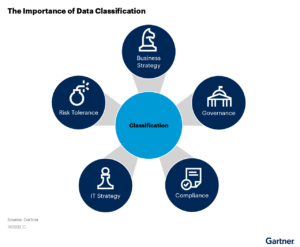In today’s data-driven landscape, regulatory compliance has become a top priority for organizations across industries. Non-compliance with data protection regulations can result in hefty fines, legal consequences, and reputational damage.
To navigate this complex regulatory landscape and ensure compliance, organizations need right-fit tools and solutions. One such solution is Data Identification Manager, a powerful tool designed to facilitate data identification processes and help organizations achieve regulatory compliance.
In this blog, we will explore how Data Identification Manager enables organizations to meet regulatory requirements, protect sensitive data, and mitigate compliance risks effectively.
I. Understanding Regulatory Compliance and Its Challenges
Regulatory compliance ensures that organizations adhere to legal requirements, industry standards, and data protection regulations. Failure to comply can result in severe consequences, including financial penalties, reputational damage, and loss of customer trust.
Examples of such regulations include the General Data Protection Regulation (GDPR), the Health Insurance Portability and Accountability Act (HIPAA), and the California Consumer Privacy Act (CCPA).
Achieving regulatory compliance is not a one-time task but an ongoing process that requires a systematic approach to data management. This is where Data 443’s Data Identification Manager comes into play.
II. The Role of Data Identification Manager in Regulatory Compliance
Data Identification Manager plays a key role in helping organizations stay compliant. By automating data identification and classification processes, the tool assists in identifying sensitive and regulated data within an organization’s data ecosystem, regardless of its location.
It assigns metadata tags or labels to data based on predefined criteria such as personal information, financial data, or health records.
This categorization enables organizations to implement appropriate data protection measures, access controls, and data handling procedures in accordance with regulatory requirements.
III. Data Identification and Classification:
Data Identification Manager provides robust capabilities for data identification and classification, which are foundational elements of regulatory compliance.

By automatically scanning and analyzing data, DIM can identify and classify sensitive information based on predefined criteria such as personally identifiable information (PII), financial data, or health records. This ensures that organizations have a clear understanding of the types of data they possess and can apply appropriate data protection measure.
IV. Data Access Controls and Encryption:
Another critical aspect of regulatory compliance is controlling access to sensitive data. DIM allows organizations to implement granular access controls, ensuring that only authorized individuals can access sensitive information.
DIM’s encryption capabilities protect and secure your sensitive data, both at rest and in flight.
V. Auditing and Reporting:
DIM software provides robust auditing and reporting features, which are essential for demonstrating compliance to regulatory authorities. It tracks data access, modifications, and user activities, creating a comprehensive audit trail. These audit logs can be used to generate compliance reports, showcasing adherence to regulatory requirements and facilitating regulatory audits.
VI. How Does Data Identifiation Manager Simplify Data Governance
a.Automated Data Classification:
Data Identification Manager uses advanced algorithms and machine learning techniques to automatically classify data. This fast-tracks the identification of sensitive and regulated data, reducing the manual effort required for compliance.
b.Metadata Management:
Efficient metadata management allows efficient metadata management, allowing organizations to define and manage metadata attributes specific to regulatory compliance. This enhances data discoverability, searchability, and understanding.
c.Regulatory Mapping:
Your organization can map data elements to specific regulatory requirements. DIM helps identify which regulations apply to specific data sets, ensuring compliance measures are implemented accordingly.
d.Data Protection Measures:
Implement necessary data protection measures to comply with regulations. DIM supports encryption, access controls, data masking, and anonymization techniques to safeguard sensitive information.
e.Auditing and Reporting:
Data Identification Manager provides auditing and reporting capabilities, allowing organizations to generate compliance reports, track data access and usage, and demonstrate compliance during audits.
VII. Use Cases of Data Identification Manager
a.GDPR Compliance:
Identify and protect personal data, manage data subject rights, and ensure cross-border data transfers comply with GDPR requirements.
b.HIPAA Compliance:
Identify and protect health information (PHI), implementing access controls, and maintaining audit trails to meet HIPAA compliance standards.
c.CCPA Compliance:
Identify and manage personal information of California residents, enabling compliance with CCPA regulations, including data subject rights and consumer data deletion requests.
d.Financial Regulations:
Comply with financial regulations such as the Payment Card Industry Data Security Standard (PCI DSS) by identifying and protecting financial data, such as credit card numbers, and enforcing secure data handling practices.
VIII. Best Practices for Achieving Regulatory Compliance with Data Identification Manager
a.Establish a Data Governance Framework:
Implement a comprehensive data governance framework that incorporates data identification and classification as essential components.
b.Conduct Regular Data Audits:
Regularly audit data assets to identify any gaps in compliance and ensure ongoing adherence to regulatory requirements.
c.Educate and Train Employees:
Provide training and awareness programs to employees regarding data protection, privacy regulations, and the proper handling of sensitive information.
d.Stay Abreast on Top of Regulatory Updates:
Monitor changes in regulatory landscape and update data identification and classification policies accordingly.
As the regulatory landscape continues to evolve, implementing an effective data identification strategy supported by Data Identification Manager becomes increasingly essential to ensure compliance, gain customer trust, and protect the organization’s reputation.
